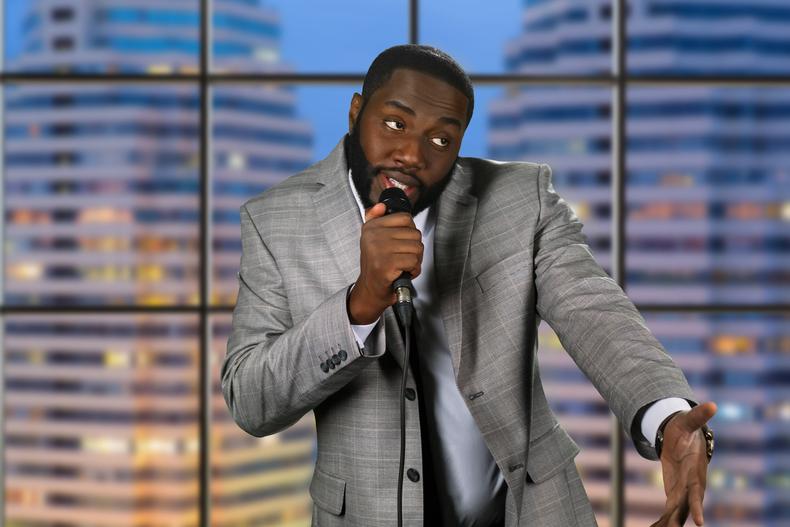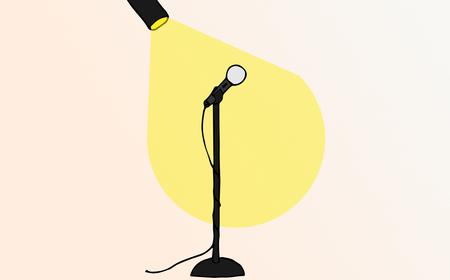
From the corniest dad pun to the bleakest gallows humor, joke-writing is an art—and it's not just for standup comedians. To master this craft, you must know what makes people laugh, understand joke structure, and practice—a lot. Keep reading to learn how to amuse and delight through the art of writing a joke.
JUMP TO
A joke is a statement or story that makes people laugh. It usually contains a setup and a punch line, creating humor in the gap between expectation and delivery. It can take the shape of anything from a single pithy sentence—such as Mitch Hedberg’s one-liner, “An escalator can never break: it can only become stairs”—to a lengthy story, such as John Mulaney recounting the time he played the song “What’s New Pussycat?” 21 times in a diner.
“A joke is a short humorous piece of oral literature in which the funniness culminates in the final sentence, called the punch line,” says linguist Robert Hetzron, who notes that a joke should end on the point of highest tension.
 Parilov/Shutterstock
Parilov/Shutterstock
The joke is often attributed to Palamedes, a legendary Greek hero who is said to have also invented consonants, coinage, measures, and dice (it seems he had a great PR guy). Not to knock (knock) on Palamedes, but the oldest known joke actually predates his appearance in the seventh-century B.C. epic poem “The Cypria.” A Sumerian joke hailing from 1900 B.C. proves that humankind has always appreciated toilet humor. It reads: “Something which has never occurred since time immemorial; a young woman did not fart in her husband’s lap.”
Jokes are also found in pre-classical texts from Egypt, Greece, and Rome. The most ancient surviving joke anthology, “Philogelos,” gives a glimpse to fourth- and fifth-century humor, from poking fun at drunkards and sexually desirious women to comedic wordplay.
The art of the joke experienced a renaissance (fittingly) during the Renaissance with the publication of the satirical, scatological “Facetiae.” Shakespeare mastered the art of the one-liner by the turn of the 17th century; and by the time “Joe Miller’s Jests” was published in the 18th century, jokes were briefer and punchier than ever before. Broadsides and chapbooks from the 19th century brought joke anthologies to the home, and by the late 19th and early 20th century, standup comedians started performing at vaudeville and music halls.
The most common jokes include:
Anecdotal
These jokes are confessional in nature—the humor comes from the comedian’s ability to recount tales from their personal lives while highlighting and amplifying the funniest parts. For example, Bert Kreischer’s 14-minute story about getting the nickname “The Machine” became so well-known it’s now being turned into its own feature film.
Observational
These relatable jokes about everyday life often begin with “Have you ever noticed…?” Comedian Red Grant says his comedy is based on his “real, everyday experiences.” The best jokes are based on personal observations, he says, “because the experiences you have, the ones you base your jokes on, have likely been experienced by others, and so they can relate.” Jerry Seinfeld, whom fellow funny person Judd Apatow called “the greatest observational comedian alive,” tells a self-reflexive observational joke on “The Pen” episode of “Seinfeld”: “Have you ever noticed how they always give you the peanuts on the planes?… Who ever thought the first thing somebody wants on a plane is a peanut?”
Ironic
Ironic comedy is created in the liminal space between a statement’s text and subtext. A classic, from comedian Steven Wright: “I’d kill for a Nobel Peace Prize.”
Who knew Alanis Morissette’s “Ironic” was just a lyrical joke? (Of course, the great irony of that song is that very few of her examples of irony are actually ironic. Perhaps she was being metatextual.)
Dark humor
Black or dark comedy pokes fun at heavy and taboo topics such as death, violence, and disease. Richard Pryor, for example, turned one of the bleakest moments of his life—accidentally setting himself on fire while freebasing cocaine—into one of the most well-known standup stories of all time.
Nonsense humor
If you ever got through “Waiting for Godot” (good on you!) or are a cultured connoisseur of internet memes, you should be familiar with the unexpected chuckles surrealist nonsense humor can inspire. You can find surrealist jokes in pretty much any clip from “The Eric Andre Show,” where Andre and co-host Hannibal Buress upend the talk show format with non-stop absurdism.
Slapstick
From the Three Stooges trying to chop down a tree to get a golf ball, to the “Jackass” crew running through Tokyo in panda suits, slapstick comedy relies on exaggerated physical activity to get laughs.
Dry
Dry or deadpan jokes are deliberately emotionally neutral, which contrasts with the content of the joke itself. Think of Tig Notaro’s trademark sardonic delivery when discussing her personal life.
Shock
Sex, drugs, swearing, and general grossities comprise shock humor, which is often used by shock jocks and 13-year-olds.
Wordplay
Puns, euphemisms, and limericks, oh my! Wordplay humor lives up to its name by playing with words in a comedic way. For example, this joke is always a hit with grammar nerds: “The past, the present, and the future walked into a bar. It was tense.”
 DenisProduction.com/Shutterstock
DenisProduction.com/Shutterstock
According to psychology professor Alex Borgella, a joke is funny for one or more of the following reasons:
- Superiority: Humor that comes from reveling in another person’s misfortune makes us feel superior, and that feeling makes us laugh.
- Relief: We carry tension that is released upon acknowledging a usually unspoken topic in a safe space.
- Incongruity: Conflicting ideas, bizarre juxtapositions, and any other gaps between expectations and reality create comedy.
Superiority, relief, and incongruity theories of humor are unified under the benign violations theory (BVT). BVT theorizes that a joke is funny when it meets three necessary conditions:
- “The presence of some sort of norm violation, be it a moral norm violation (robbing a retirement home), social norm violation (breaking up with a long-term boyfriend via text message), or physical norm violation (purposefully sneezing directly on a child).
- A ‘benign’ or ‘safe’ context in which the violation takes place (this can take many forms).
- The interpretation of the first two points simultaneously. In other words, one must view, read, or otherwise interpret a violation as relatively harmless.”
For example, in this joke, Jim Gaffigan violates the norm of calling people “fat” (number 1) while calling himself fat (number 2), thus creating a benign environment, which viewers interpret simultaneously (number 3), making it funny. Beyond its content, other elements that make a good joke include comedic timing (the pace and pauses of the joke) and delivery (the way the punch line is delivered).
The structure of a joke varies, but the general format includes setup, which introduces the characters, settings, and situation; and punch line, which delivers the plot twist or benign violation. Jokes also have narrative elements: character(s), story arc, conflict, and resolution.
If you want to write a longer joke, consider peppering the entire anecdote with smaller joke clusters: mini setups and punch lines within the larger structure of the story. These “jab lines” incorporate humor throughout the entire joke-text.
 How To Become a Standup Comedian
How To Become a Standup Comedian  mimagephotography/Shutterstock
mimagephotography/Shutterstock
Every good joke begins as an idea. That idea is then tweaked and polished into a magical moment that makes people laugh. To start writing jokes:
- Study the greats. Watch performances by comedians that make you laugh. Take notes on their content, pacing, and delivery, and see if you can apply these elements to your own comedy.
- Research. If you’re stalling on joke ideas, research a variety of topics (for example, celebrities, politics, everyday experiences like riding the bus) and see if you can come up with a benign violation about those topics. “There are millions of topics out there,” Grant says. “There’s a whole world of jokes waiting to be written and delivered to an audience.”
- Write it out. Writing creates a tangible record of your ideas. It allows you to transform your ideas into jokes instead of losing them to the trappings of memory.
- Add structure. Now that you have some ideas, it’s time to structure them as jokes. Grant advises thinking of the joke as analogous to an essay: “When I write jokes, I follow that structure: beginning, middle, end. The topic is the beginning. The crazy stuff you do in the middle is the body. And you always have to end on some type of laugh that makes sense to sum up the joke, aka the punch line.”
- Build comedy throughout. Include multiple moments of humor throughout longer jokes. Jab lines make your audience laugh even before hearing the punch line.
- Create a powerful punch line. It’s called a punch line because it’s supposed to pack a punch. Surprise your audience by playing with differences between expectations and reality. Keep the punch line brief, surprising, and of course, funny.
- Revise. Once you’re done with the first draft of your joke, take a break to clear your mind, and then take your time revising. Unnecessary words and overly lengthy exposition can lose audiences. Clear those out and make your joke as brief and concise as possible—while still providing the narrative complexity needed to understand the joke.
- Test it out. Practice reading your joke aloud to refine pacing and delivery. Then, test it out on friends, family, internet strangers, whomever! If it gets a laugh, you’re on the right track. If not, take another tackle at the joke, or scrap it and try writing a new one. “I’ve written over 10,000 jokes in my career. Some I’ve used and some… I would never be able to use all of them,” Grant says. “But that’s OK. I would rather have an overflow of jokes than no jokes at all.”
- Perform. Once you’re confident your joke can make people laugh, aim big by making a self-tape—or bigger by shooting your shot at a local comedy show. Performing will give you the most information about whether or not your jokes are landing the way you want.
You’re ready to start crafting your own witticisms, wisecracks, and japes. Have fun with the process—and remember to laugh.



















